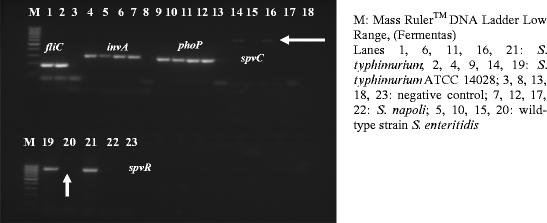Fig. 25.1
Mean value of the mesophilic and psycrophilic aerobic counts of fresh fish, ice fish, and defreezing water
L. grayi was isolated from 8% of the samples, L. ivanovii from 3.5%, and both L. innocua and L. welshimeri from 2.3% of the samples. S. napoli, sensitive to all tested antibiotics, and S. typhimurium, resistant to streptomycin, ampicillin, chloramphenicol, and sulfonamide, were isolated, respectively, from two samples of ice fish (PG 15 and PG 21). For the first serotype, only genes invA and phoP were identified, while S. typhimurium possessed the fliC gene (Fig. 25.2), which identified the serotype, and the virulence factors examined. Escherichia adecarboxylata, E. hermannii, Enterobacter cloacae, and Citrobacter youngae, microorganisms widespread in the environment but not necessarily related to fecal contamination, were isolated from 19.0% of the frozen samples. Shewanella putrefaciens, a spoilage bacterium highly widespread in frozen and chilled fishery products, was isolated in PG H2O 11.


Fig. 25.2
Pulsed-field gel electropherogram of the amplicons fliC, invA, phoP, spvC, and spvR in the isolates of S. enterica
25.4 Discussion
The values related to mesophilic aerobic counts for fresh products, recommended by the International Commission on Microbiological Specification for Foods (ICMSF), must be below 7 log CFU/g. Twenty percent of the samples of A. minuta and the 8.7% of the samples of S. pilchardus exceeded this limit. This finding could be due to the habitats where these species live: “rossetto” lives in sandy and muddy seabeds at a depth of 80 m, while “bianchetto” lives generally between 25 and 35 m (Relini et al. 1999; Lucchetti 2006).
Stay updated, free articles. Join our Telegram channel

Full access? Get Clinical Tree


